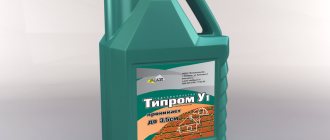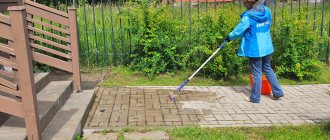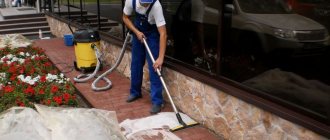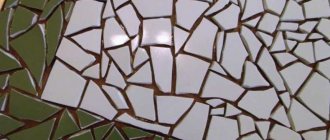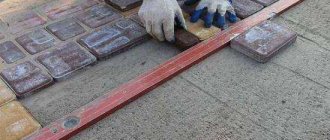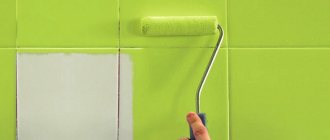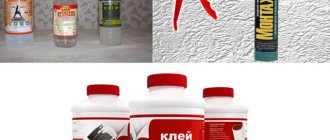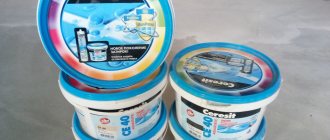On pedestrian zones, bicycle paths, squares and parks of modern streets, you almost no longer see dull gray asphalt. It was replaced by such a new material as paving slabs. Possessing a wide variety of shapes, colors, affordable prices and simple installation, these man-made paving stones have become very popular in the design of personal plots.
However, despite all the advantages, this material has one significant drawback - like all concrete structures, this material is very damaged when exposed to moisture.
This deficiency of the material can be eliminated and protected from the destructive effects of moisture using a water repellent for paving slabs - a special impregnation applied to the surface of concrete and forming a dense water-repellent film.
Figure 1. Water repellent for paving slabs
Why treat already laid tiles?
Treatment with a water repellent allows:
- protect the material from moisture;
- make concrete more durable and resistant to mechanical stress;
- increase the frost resistance of the coating;
- protect the coating from the appearance of growths of moss and lichens
- prevent the formation of efflorescence;
- increase the abrasion resistance of the coating;
- increase the service life of the coating;
- reduce the frequency and quantity of repair work;
- give the tiles a more saturated color.
Figure 2. Paving covering with a water-repellent composition applied to it
How to coat natural stone?
Since time immemorial, finishing with natural stone has been highly valued when decorating houses, apartments, and enterprises due to its reliability, durability, simple processing and pristine beauty maintained over a long time. But in order for its performance to last longer, it must be coated with various materials. They will resist environmental influences, high humidity, mold and wood-staining fungi. Coating of natural stone is done using a varnish base and impregnation. What exactly to choose and why, we will consider further.
Ways to protect paving slabs
To protect paving slabs, the following highly specialized solutions and impregnations are used:
- decorative - impregnations that serve to improve the appearance of the coating, giving it rich color and shine;
- cleaning – special solutions designed to remove traces of various contaminants (small particles of soil, oil, fat, salt deposits), lichen growths, moss from the surface of the material;
- antifungal – antiseptic solutions that prevent the development and spread of various microorganisms on the surface of garden paths and sidewalks;
- water repellents – solutions that increase the resistance of the material to moisture, increasing the strength and frost resistance of the tiles.
General information
Application of gypsum
Gypsum stone has a beautiful shape, and it also closely resembles brick or faux tiles, and also looks great when facing doorways and walls. Moreover, it can be used in combination with tiles, plaster, wood, photo wallpaper, as well as simple wallpaper. Gypsum stones are used either as fragmentary or complete finishing of premises. The stone is used for cladding fireplaces and emphasizing the base of columns. Gypsum stucco molding is sold in hardware stores, and they also sell moldings made from this material, used to decorate walls and ceilings. From gypsum powder you can make beautiful figurines for the garden, figurines, and various sculptures.
Advantages
Various building mixtures are made on the basis of gypsum, both for internal and external types of work. Dry gypsum is added to many putties, adhesives and plasters as an excellent binding component. This material is added to the majority of many construction and finishing materials, because it will have the following advantages:
External beauty.- A small mass that will be combined with a high degree of strength.
- Creates excellent noise and heat insulation.
- They can be used to make beautiful, unique products for decorating the exterior and interior.
- Environmentally friendly and safe material for human health.
- Mold and fungal colonies will not settle on it.
- It is a vapor-permeable material that breathes.
- Very easy to process and can be applied to all types of surfaces.
- Using affordable and uncommon tools, you can easily change the shape of plaster products.
How to apply varnish?
Types of varnish for paving slabs with a wet effect and which one is better
In addition to the water repellent, partial protection of this material from moisture, as well as improving the appearance of the coating, is provided by a varnish with a wet effect. The most common and widely used acrylic varnishes are of two types:
- water-based - do not contain toxic components harmful to health, which is why they are used for processing tiles in garages and gazebos;
- solvent-based - such varnishes are used for application to areas of paving surfaces located in the open air (garden paths, garage driveways, areas around gazebos, porches).
Figure 3. Acrylic varnish on the sidewalk
Important. Solvent-based varnishes cannot be used indoors - the volatile components they contain can cause damage to the respiratory system, the mucous membrane of the eyes, and the skin. The fumes from this composition can be dangerous even when applied to outdoor garden paths. Therefore, in order to avoid poisoning and eye damage, even with small amounts of work, it is necessary to use a respirator and safety glasses.
Features of gypsum finishing materials
Gypsum products are divided into two types according to their intended purpose. The first, facing, is used for decorating buildings: facades, balconies, gazebos, protruding corners of houses. The second type, finishing materials, are used in the interior. They can be found in the decor of walls, doorways, ceilings, arches, fireplaces and stoves, and individual objects (for example, wall mirrors).
Popular varieties of plaster finishes mimic the textures of brick or stone. The decor is made from a gypsum mixture (alabaster can be used instead of gypsum), industrially or manually. If you compare gypsum tiles with ceramics, mosaics, flexible or natural stone, the following advantages become noticeable:
- Light weight. Lightweight trim is much easier to transport, unload and install. The weight of the gypsum finish is not critical even for a plasterboard structure.
- Easy installation. The material does not require a complex and expensive supporting profile structure. The tiles are attached directly to the wall; careful leveling of the surface is not necessary.
Imitation of natural stone Source slatic.net
- Budget cost. Gypsum is a common and therefore cheap natural material. The use of gypsum finishing in interior design will save a significant portion of the funds allocated for repairs.
- Variety of designs. On sale are products that imitate shapes of brick and natural stone of different colors and textures. You can always choose an option to suit any interior style.
Gypsum decor has two significant drawbacks. Fragility can manifest itself even with a relatively harmless mechanical impact: a slight impact will provoke the appearance of cracks and chips. The second disadvantage is low resistance to moisture. Because of this, such decor cannot be used in the bathroom or kitchen, where the air is humid. In other rooms it is strongly recommended to use decorative stone varnish. It will create a protective layer and help the decorative surface last longer.
The gypsum surface needs protection Source ytimg.com
Procedure for processing tiles
The process of applying water repellent does not require special skills or experience. You just need to purchase the necessary materials, prepare the tools, clean the work surface, and then carefully apply several layers of impregnation to it.
Required materials and tools
The following materials will be required for this type of work:
- water repellent;
- acrylic decorative varnish with wet stone effect;
- special detergents for the care of paving slabs (solvents for removing efflorescence and dirt).
To clean the work surface and apply a protective and decorative layer, you will need the following tools:
- a brush or broom with plastic rods;
- wide brush or hand sprayer;
- 2 buckets for water repellent and varnish;
- roller;
- rags.
Application process Water repellent for paving slabs
Applying a water-repellent layer consists of 4 main steps:
- Cleaning the working surface from large debris - sand, soil particles.
- Removing efflorescence and grease stains from the work surface.
- Applying 1-2 layers of water repellent using a spray gun or a wide brush.
- Applying a decorative layer (varnish with a wet stone effect) using a roller.
Application
It should not be forgotten that all of these varnishes are synthetic mixtures. Therefore, personal protective equipment will not hurt. When carrying out interior work, as well as after completion of treatment, the premises must be thoroughly ventilated.
The surface to be treated should first be prepared for painting: cleaned, dusted, dried, possibly degreased, primed. The maximum air temperature during work should not exceed +35°.
The quick-drying polymer composition can be applied by brush or roller, also by airless or pneumatic spraying. In the last two cases, the substance should be diluted to working viscosity. Acrylic, polyurethane, silicone varnishes are also applied with a similar painting tool.
It is recommended to cover the surface to be treated with at least two layers, especially if the surface of the stone has a porous structure.
Varnishes for mineral materials extend the life of the room or the building itself. Therefore, it is so important to approach the choice of product with special care. Before purchasing, you need to determine which of the proposed varnishes is more suitable for your case, calculate the consumption, costs of preparation and execution of the work. Special varnishing of concrete and stone surfaces will provide long-term and high-quality protection during operation.
Water repellent or tile varnish: which is better?
When choosing between these two protective solutions, a multifunctional water repellent is more advantageous and reliable. This is explained by the fact that, compared to decorative varnish, this moisture-proof material has the following advantages:
- it more effectively protects the paving surface from moisture and abrasion;
- The resistance of the water repellent to aggressive substances is much higher than that of decorative varnish;
- a water-repellent layer applied to the working surface of the sidewalk increases its mechanical strength;
- the cost of both the water-repellent impregnation itself and the work required to apply it is significantly less than that of acrylic decorative varnish.
Useful tips
It is important to remember that tiles can only be processed a month after they have been laid. Tile adhesive takes quite a long time to dry, so you should be patient and wait just that long.
After carrying out work on treated tiles, it is better not to walk for at least 24-28 hours.
- After varnishing work, contact with the tiles will become much easier.
- It will become easier to wash, and it will dry in a matter of minutes.
- It will become less porous, roughness will go away, and thus a dirty, difficult-to-clean coating will not form.
- The tiles will delight you with a beautiful shine and brightness of tones, and the interior will be filled with cleanliness, novelty and freshness.
By observing all recommendations and safety precautions and strictly following the instructions included with the varnish, you can easily and simply make repairs.
Then there will be not only joy, but also pride in the repair work carried out independently in your home.
Popular hydrophobic solutions
Among the wide variety of moisture-proof solutions for treating paving slabs, the most popular are the following brands:
- "Aquasil";
- "TipromU";
- "Crystallizol";
- "Ceresit ST 10,11,12,13";
- "VOKA".
Figure 4. Characteristics of popular water repellents for paving slabs
Product varieties
We have already mentioned that there are different types of impregnations that differ in composition and principle of action. This is useful because you have the option to choose the right products for your circumstances. Thanks to the product, the appearance of the stone is preserved, it does not fade, does not lose color and lasts a long time. In addition, the film protects the surface from small cracks, potholes and chips. The material becomes denser.
There are deep penetration substances. They enter the structure of the stone, closing the pores and polymerizing the material. These are hydrophobic mixtures that will protect the surface from moisture. Depending on the composition, the following types of products are distinguished:
Hydrophobic impregnations are suitable for different types of stones, both artificial and natural. They can process granite or porcelain stoneware, marble, gypsum, sandstone or cement stone.
Tips for using impregnation
- all work on applying water repellent is carried out in moderately warm and windless sunny weather;
- after heavy rainfall, application should be made after the working surface has completely dried;
- Before applying impregnation, be sure to inspect the seams between the tiles, filling the voids;
- You can check the quality of the applied moisture-protective layer by pouring a little water onto the working surface - if the solution has been distributed efficiently and evenly over the surface of the concrete, the water will collect in small puddles and flow towards the slope.
Conditions under which surface varnishing is unacceptable
In some cases, it is not recommended to apply varnish to ceramic tiles:
- If the tile adhesive has not hardened enough. It takes at least one month for the glue to dry. To speed up the process, it is recommended to lay the tiles with cement adhesive, which will reduce the waiting time.
- If the surface is poorly insulated from moisture penetration, applying paints and varnishes is also not recommended.
Summarizing the above, we can say with confidence that varnishing ceramic floor tiles is a way to renew them and extend their service life. But for this you need to choose a varnish suitable for ceramic surfaces. The technology for applying varnish is simple - even a non-professional can handle it.
